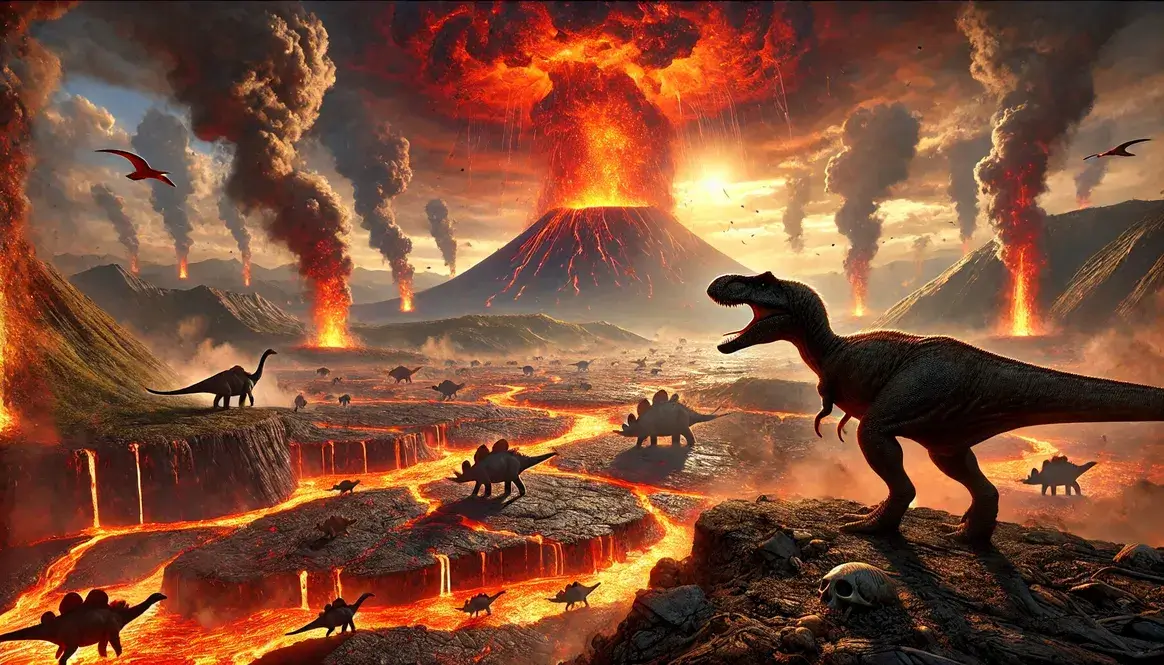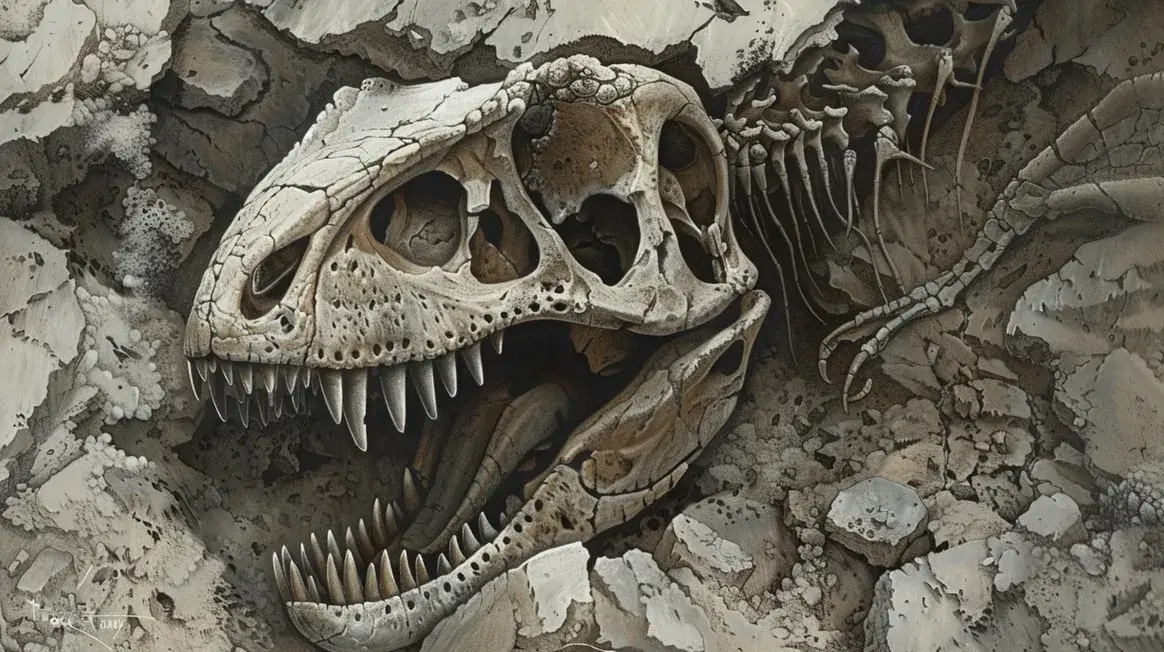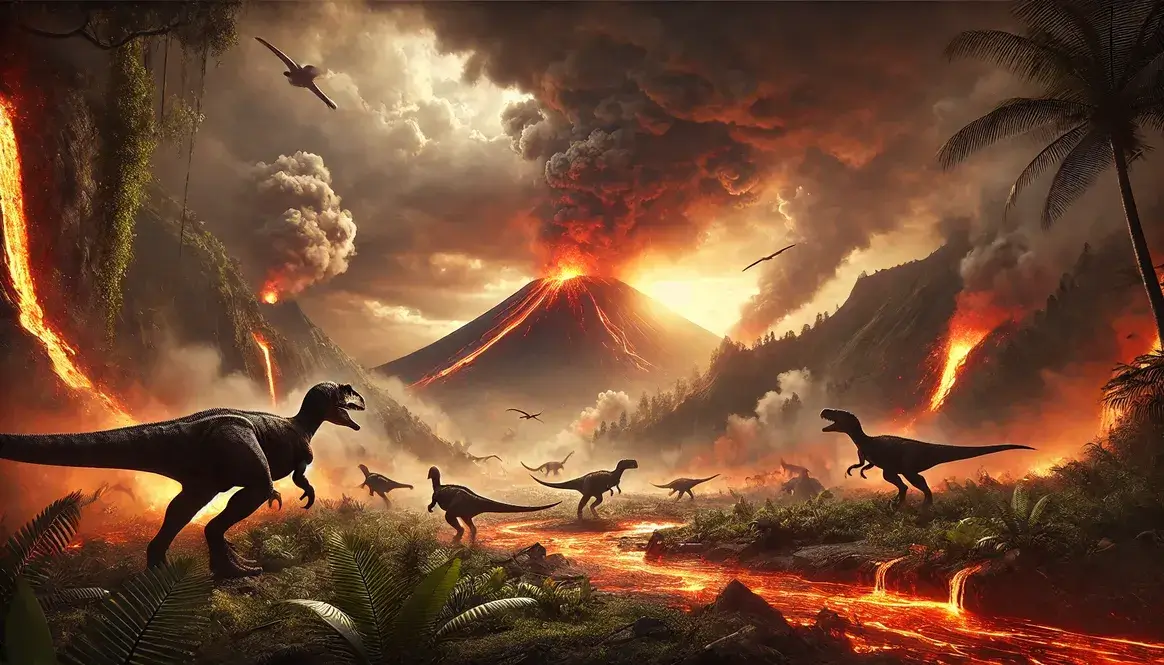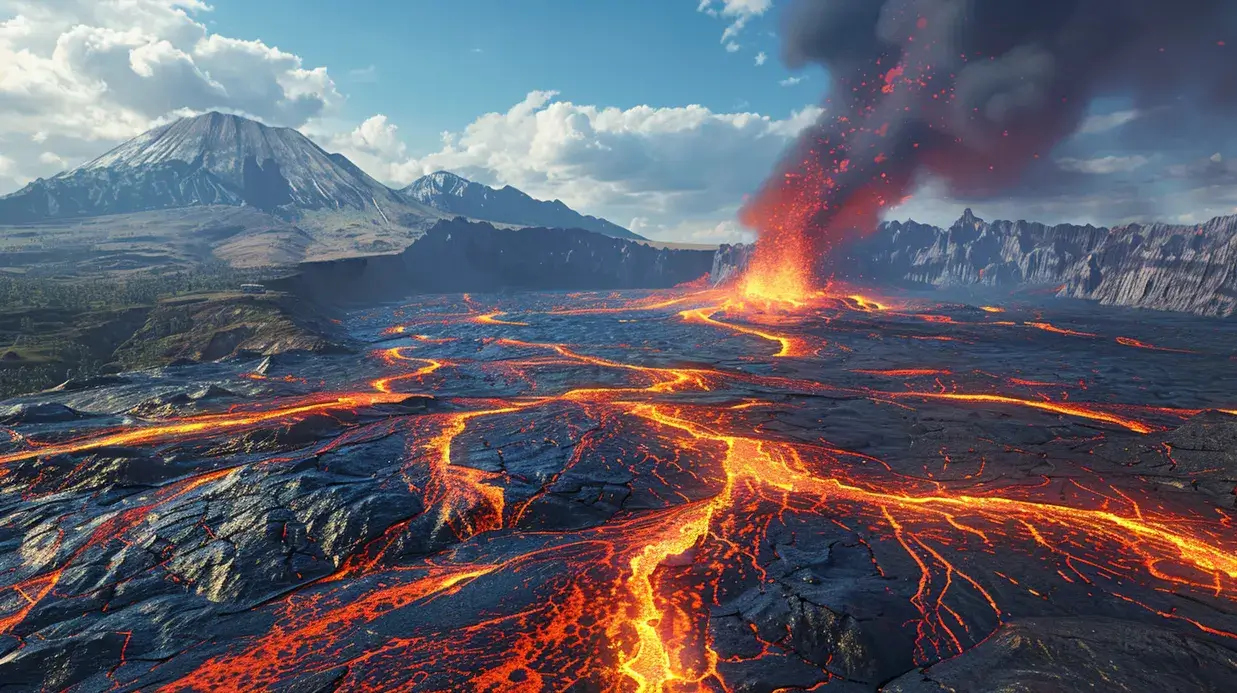The Deccan Traps erupted around 66 million years ago, right when dinosaurs were taking their final breaths. These weren’t your average volcanoes – they were massive lava flows that covered an area bigger than Texas! Let’s dig into when these epic eruptions happened and why they’re so important.
| Key Information | Timeline |
|---|---|
| Eruption Start | ~66 million years ago |
| Main Phase | 66.3 to 65.5 million years ago |
| Eruption End | ~65 million years ago |
| Total Duration | ~1 million years |
| Relation to K-Pg Boundary | Overlapped with dinosaur extinction |
The Deccan Traps eruption timeline
So, when did the Deccan Traps erupt? The short answer is that they started spewing lava about 66 million years ago. But like many things in Earth’s history, it’s not that simple. These eruptions weren’t a one-and-done event. They kept going for about a million years!
Main phases of volcanic activity
The Deccan Traps didn’t just erupt all at once. They had different phases, kind of like chapters in a book. Here’s how it played out:
- Early rumbles: Around 66.3 million years ago, the first lava started to flow. This was like a warm-up act.
- The main event: From 66.3 to 65.5 million years ago, things got really intense. This is when most of the lava came out. Imagine rivers of molten rock covering an area larger than many countries!
- The finale: The eruptions started to slow down around 65.5 million years ago, but they didn’t stop completely until about 65 million years ago.
Each of these phases left its mark on the Earth, creating layers of rock that scientists can study today.
Relationship to the K-Pg boundary
Now, here’s where things get really interesting. The K-Pg boundary is a thin layer of rock that marks the end of the dinosaur age. And guess what? The main phase of the Deccan Traps eruptions happened right around this time!
This timing is super important. It means the Deccan Traps were erupting when the dinosaurs went extinct. Some scientists think these massive lava flows might have played a big role in the extinction.
But it’s not that simple. There was also a giant asteroid that hit Earth around the same time. So, was it the volcanoes, the asteroid, or both that caused the dinosaurs to die out? That’s a question scientists are still trying to answer.
The Deccan Traps eruptions and the K-Pg boundary are like two pieces of a puzzle. Understanding when the Deccan Traps erupted helps us figure out what was going on when the dinosaurs disappeared. It’s like being a detective, but instead of solving a crime, we’re solving a 66-million-year-old mystery!
Did the Deccan Traps kill dinosaurs? That’s a question that keeps popping up in this prehistoric whodunit. The timing of these massive eruptions certainly makes them a prime suspect!
Dating the Deccan Traps eruptions
But how do scientists know when the Deccan Traps erupted? They can’t just look at a calendar from 66 million years ago! Instead, they use some pretty cool scientific methods to figure out the age of these ancient lava flows.
Radiometric dating techniques
One of the main ways scientists date the Deccan Traps is through radiometric dating. It’s like a super-accurate clock for rocks! Here’s how it works:
- Scientists look for special elements in the volcanic rocks.
- These elements slowly change into other elements over time.
- By measuring how much of each element is left, they can tell how old the rock is.
For the Deccan Traps, scientists often use a method called argon-argon dating. It’s super precise and can tell us the age of these rocks within about 100,000 years. That might sound like a long time to us, but when you’re dealing with millions of years, it’s pretty accurate!
Magnetostratigraphy
Now, here’s where things get really wild. Did you know that Earth’s magnetic field flips every now and then? It’s true! And these flips leave a mark in rocks, including the Deccan Traps.
Scientists use a method called magnetostratigraphy to study these magnetic “fingerprints” in the rocks. It’s like reading a book, but instead of words, they’re reading the direction of tiny magnetic particles frozen in the lava.
By matching these magnetic patterns to known timelines of Earth’s magnetic field flips, scientists can figure out when different parts of the Deccan Traps formed. It’s like putting together a giant, million-year-old puzzle!
Fossil evidence
Believe it or not, fossils play a big role in dating the Deccan Traps too. While you won’t find any dinosaur bones in the lava itself (they’d be toast!), scientists look at fossils in the rocks above and below the lava flows.
These fossils are like bookmarks in Earth’s history. They tell us which animals and plants were around when the lava was flowing. Some key findings include:
- Dinosaur eggs found in rocks between lava flows
- Fossil plants that show how the environment changed
- Tiny fossils of sea creatures in marine rocks mixed with the lava
By studying these fossils, scientists can piece together the story of when the Deccan Traps erupted and how they affected ancient life.
Duration of Deccan Traps volcanic activity
The Deccan Traps weren’t just a quick burst of lava. These eruptions lasted for an incredibly long time! Let’s dive into how long these massive lava flows were active and how scientists figured it out.
Estimating eruption duration
Scientists estimate that the Deccan Traps were actively erupting for about 1 million years. That’s a really long time! To put it in perspective:
- If dinosaurs could build cities, they could have constructed and abandoned many during this time.
- Entire species could have evolved and gone extinct.
- The Earth would have made 1 million trips around the sun!
But how do scientists come up with this number? They use a combination of methods:
- Layer counting: By studying the layers of lava, scientists can estimate how many eruptions occurred.
- Radiometric dating: This helps pinpoint the start and end dates of the eruptions.
- Sedimentation rates: By looking at the rocks between lava flows, scientists can estimate how much time passed between eruptions.
It’s like being a time detective, piecing together clues from rocks to understand events that happened millions of years ago!
Pulses of volcanic activity
Now, you might be thinking, “Did the Deccan Traps just erupt non-stop for a million years?” Not exactly! The eruptions came in pulses, kind of like a very slow, very hot heartbeat.
These pulses of activity are crucial for understanding the volcanoes at end of Cretaceous and their impact on Earth’s climate and life.
Here’s what the pulsing activity looked like:
- Eruption phase: Lava would flow out, covering vast areas.
- Quiet phase: The volcanism would slow down or stop, allowing time for:
- Soil to form on top of the cooled lava
- Plants to grow
- Animals to return to the area
- Repeat: Another eruption would start, and the cycle would begin again.
This pattern repeated many times over the million-year eruption period. Scientists have identified several main pulses of activity, with the most intense occurring right around the time the dinosaurs went extinct.
The pulsing nature of the Deccan Traps eruptions is important because it helps explain how life could survive during this long period of volcanic activity. During the quiet phases, ecosystems had a chance to recover… at least until the next pulse of eruptions shook things up again!
Significance of Deccan Traps timing
The timing of the Deccan Traps eruptions is super important. It’s like finding out that a big storm happened on the same day as an important event in history. Let’s explore why when these massive lava flows occurred matters so much for understanding Earth’s past.
Impact on global climate
The Deccan Traps eruptions weren’t just big – they were climate-changers! These eruptions released huge amounts of gases and particles into the air, which had major effects on Earth’s climate. Here’s how:
- Cooling effect: Ash and sulfur dioxide from the eruptions could block sunlight, cooling the Earth.
- Warming effect: Carbon dioxide released by the lava could trap heat, warming the planet.
- Acid rain: Sulfur in the atmosphere could cause acid rain, harming plants and animals.
These effects didn’t happen all at once. Because the eruptions came in pulses, the climate impacts also came in waves. This on-again, off-again pattern of climate change would have been really tough for plants and animals to deal with!
Want to learn more about how volcanoes change climate? Check out our detailed article on the topic!
Relationship to mass extinction
Now, here’s where things get really interesting. The timing of the Deccan Traps eruptions lines up closely with the end-Cretaceous mass extinction – you know, when the dinosaurs died out.
This timing has led to a big debate among scientists. Some think the Deccan Traps played a major role in the extinction, while others believe an asteroid impact was the main culprit. Here’s why the timing matters:
- Just before the extinction: The most intense phase of eruptions happened right before the extinction event.
- Long-term stress: The long duration of eruptions could have stressed ecosystems for a long time.
- Double whammy: The eruptions might have weakened ecosystems, making them more vulnerable to the asteroid impact.
It’s like trying to figure out if a tree fell because of a storm, because someone cut it, or both. The timing of the Deccan Traps eruptions makes them a key suspect in the dinosaur extinction mystery.
This connection between the Deccan Traps and the mass extinction shows how big geological events can have huge impacts on life on Earth. It’s a reminder that our planet’s history is full of dramatic changes and close connections between the rock world and the living world.









